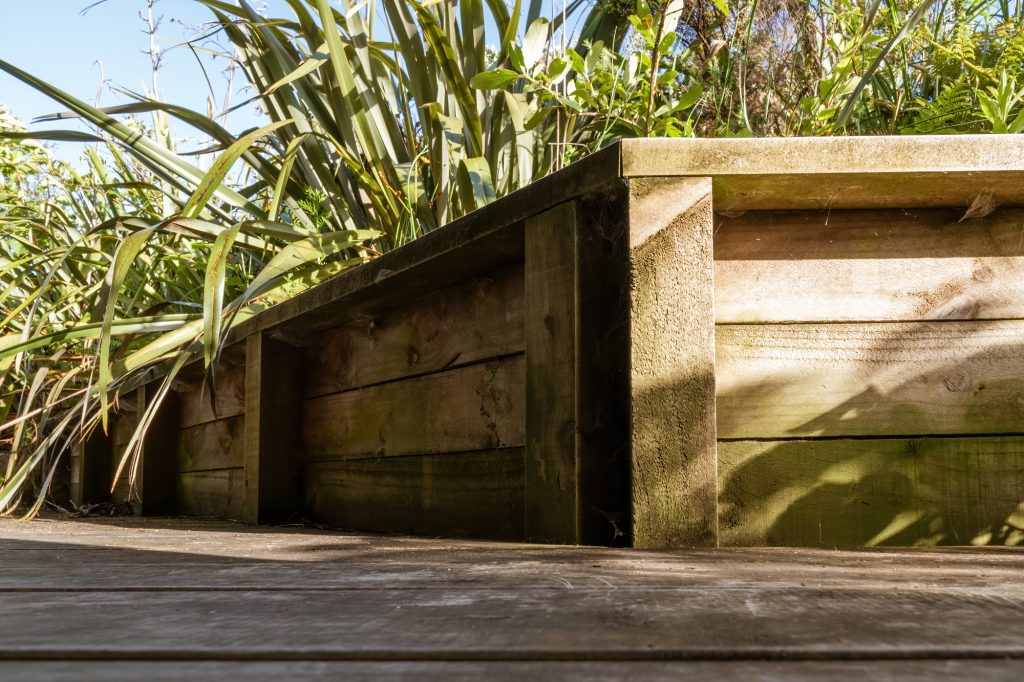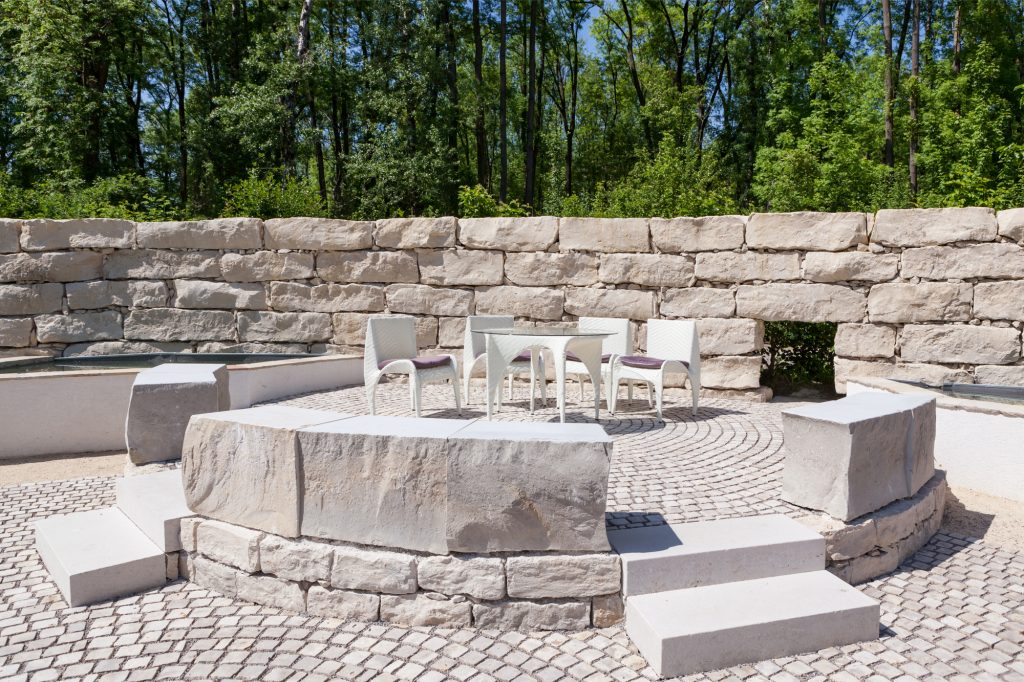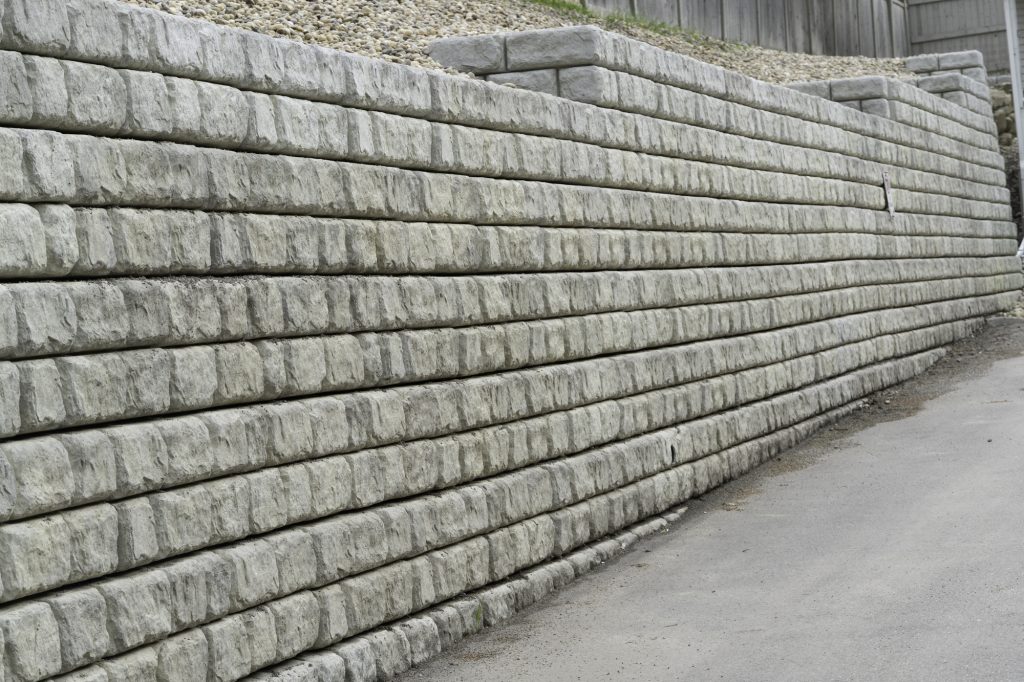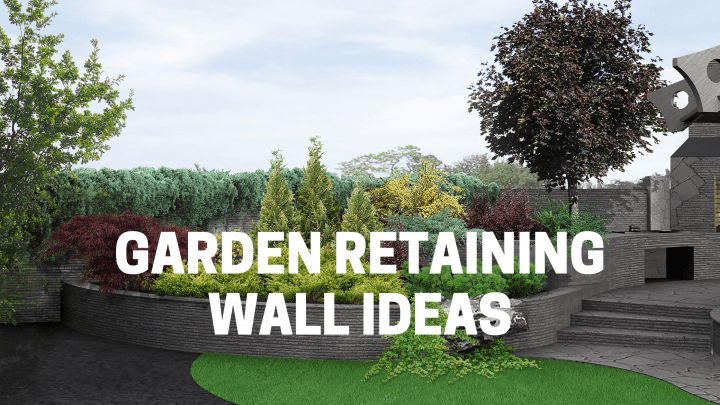Retaining garden walls are useful for practical and aesthetic reasons. They help prevent soil erosion at different elevations in your garden by bearing up to the pressure of the soil expanding as the plants grow. They’re great for creating borders and raised beds of soil in your garden.
Here are a few ideas for your garden retaining wall:
- Wood
- Stone
- Concrete
- Brick
- Mesh gabion
In this article, I’ll elaborate on how these materials can be used to build a retaining wall in your garden and how they hold up over time, so read on!
1. Wood

A retaining wall made of wood uses either wood planks or wood blocks to create a wall around garden beds. Wood is typically chosen for aesthetic reasons since the wooden walls blend into the rest of the garden and complement the garden’s overall appearance.
This is especially true for cabins and homes with a more cottage-esque appearance, where the wooden walls will blend in with the rest of the house.
Wood is also chosen because it’s cheaper and easier to work with than most materials. It’s used in building embankments for roads with low traffic, so wood is perfectly functional for retaining walls. However, the material won’t hold as much weight as other materials. To find out what kind of weight you’ll need for your retaining wall, read our article here.
You can use wooden planks or blocks to build raised garden beds on sloped land, as demonstrated in this Lowe’s Home Improvement video, ‘How to Build a Terraced Garden Bed on a Slope’:
Lowe’s Home Improvement uses pressure-treated lumber in the video. The best kind of timber or lumber would be either Douglas fir or Cedar to ensure the wood can withstand the pressure of the soil and last as long as possible.
As with all kinds of retaining walls, draining is particularly important. Without a good system for drainage, the wood will decompose faster, and your retaining wall won’t last as long.
Wood is ideal for low retaining walls not exceeding 4 feet (1.2 meters) high. Retaining walls made of well-treated, good-quality timber should last about 20 years. However, this isn’t as long as the other materials listed in this article. So if you’re looking for something that lasts a bit longer, read on.
2. Stone

Stone is another popular material used in building garden retaining walls. Like wood, stone also blends in well with the aesthetics of most gardens. There are multiple ways in which stone can be used for retaining walls.
One of the most common versions of stone retaining walls are built using rubble. This involves using stones of random sizes and shapes tightly dry-stacked together, meaning they’re stacked without any bonding material between the stones.
Unfortunately, this is time-consuming and commonly results in an improper stacking of materials. This ultimately affects the overall stability of the structure and its durability.
Apart from rubble, you can use natural stone as well.
Stone has been used as a material for building retaining walls for centuries. It’s favored by many because it’s durable and anchors well into the ground. Not to mention, it’s effective in preventing soil erosion and creating raised beds.
All kinds of stones tend to be more expensive in terms of both labor and the material itself. Stone isn’t easy to work with, and you can’t build a stone retaining wall without help, especially if your wall is to be higher than 3 feet (0.9 meters).
While stone garden retaining walls may be expensive, they’re longer lasting than most materials. Additionally, natural stone allows for easy drainage without the issue of rotting away like wood. This makes it an excellent material to use in rainy areas.
3. Concrete

Concrete retaining walls are poured concrete or interlocking concrete blocks to create a wall around your garden.
Poured concrete or masonry walls are a single mass that obstructs soil erosion. While the walls themselves are effective, drainage is a problem with concrete as the material doesn’t allow water to flow freely or seep through in any way, unlike wood or concrete.
It’s essential to map out a good drainage plan to build a poured concrete wall. Weep holes placed every four to ten feet (1.2 to 3 meters) within the wall should be sufficient.
Poured concrete also tends to be hard to repair or replace since a crack can mean expensive repairs and frequently requires the entire wall to be replaced.
Most cities have general guidelines for garden retaining walls, like this one from La Cambria in California. These may vary from city to city, depending on the soil and weather conditions of the region. Nevertheless, the standard rules require that the thickness of the concrete wall be at least six inches to ensure it can hold up against the pressure of the soil.
Concrete blocks with interlocking edges are far easier to work with than poured concrete. This is mostly because they can be stacked in much the same way as a natural stone wall, but with the added security of the interlocking.
Available in garden wall size, which is lightweight and easy to move around,concrete blocks can be used by just about anyone without the need to pay extra for labor costs. However, if you’re planning to build a high wall, you might want to consider bringing in professionals to build the wall for you.
4. Brick

Bricks are a commonly used material in constructing garden retaining walls since they tend to be slightly cheaper than stone and are easier to handle, overall.
They also tend to be less time-consuming to build with than concrete blocks. Furthermore, red brick walls are more environment-friendly than concrete blocks since they’re made of clay.
Brick is also durable–though not as much as stone–and easy to maintain. Plus, it weathers well, unlike concrete, which might need regular paint touch-ups. However, brick is more expensive and heavier than concrete. Additionally, some kind of mortar might need to be used in a brick wall.
Like concrete, brick retaining walls need a carefully designed drainage system to prevent any water retention behind the wall. Weep vents installed into the brickwork can ensure good drainage. These should be installed one-third of the way up the wall.
When building a brick wall, the average thickness tends to be about one ‘skin’ (or layer) of brick. Keep in mind, this is no longer the rule of thumb when you want to build walls taller than 400 yards (365 meters) –but that’s unlikely for a garden wall.
Brick walls can be functional in multiple ways, not just as a retaining wall. For example, you could use a brick wall as a vertical surface for gardening by building holes into the wall to be used as planters. Holes in the brick wall can also be used for gardening decor like lights, lamps, decorative curios, or other elements that can be placed in small holes.
A brick wall is also useful as a structure for your smaller vines to climb on. Just make sure the wall is properly treated to prevent moisture absorption and gradual breakdown caused by the plant’s natural growth.
If you’re planning to use brick for your retaining walls, it’s advised against using sun-dried, over-burnt, or otherwise low-quality bricks. Any of these options won’t be durable enough for a wall. They will break down quickly and are better used for temporary structures or roadworks.
5. Mesh Gabion

Gabion comes from the Italian word ‘gabbione.’ The word refers to a big cage. Gabion walls are walls made of a mesh structure filled with rocks, stone, sand, or a mix of all three.
Mesh gabion walls are traditionally used for embankments, making them an excellent option for building garden retaining walls. They look natural and blend in well with the aesthetics of a garden. They also don’t have drainage issues as concrete or brick walls would.
Like stone walls, the stacking and mesh of the gabion allow water to permeate through the wall while preventing soil erosion. This prevents any water stagnation that might build up and topple the wall later.
Gabion walls are about as durable as stone walls. Moreover, they tend to become more effective over time as plants grow through the openings in the mesh wire and add to the structure’s overall stability. A wall with PVC-coated mesh could last 60 years or longer.
The cost of gabion walls varies depending on the area that needs to be walled and the rocks, stones, or pebbles used to fill up the gabion cages. They’re cheaper than a stone wall but may cost about as much as a brick wall. However, their durability and natural drainage give them an edge over a brick garden retaining wall.
You can choose from gabion baskets, sacks, wire mesh, or mattresses to build your gabion wall. Retaining walls for home gardens are typically built using gabion baskets.
These walls tend to be easier to climb than other kinds of materials, so you may not want to use mesh gabion for your perimeter walls if you have security concerns.
Final Thoughts
If you’re hungry for more ideas and information, we wrote an entire series on retaining walls. Check out our guides to put yourself on the path to getting your own.
Sources
- Transportation Research Board: TIMBER CRIB RETAINING STRUCTURES
- YouTube: Lowe’s Home Improvement: How to Build a Terraced Garden Bed on a Slope
- Nonprofit Home Inspections: Common Retaining Wall Problems
- The Construction Civil: Retaining Walls – Types, Design, Stability
- National Concrete Masonry Association (NCMA): CONCRETE MASONRY GRAVITY RETAINING WALLS
- The Children’s Museum at La Habra: STANDARD BLOCK WALL (GARDEN WALL)
- Duke University: Chapter 1 – Retaining Wall
- DIY Doctor: How to Build a Garden Retaining Wall
- Hebei Lvhua Gabion Wall Co., Ltd.: home page
- World Research Library: GABION WALLS AND THEIR USE
- Soils Matter, Get the Scoop!: How do retaining walls work?

